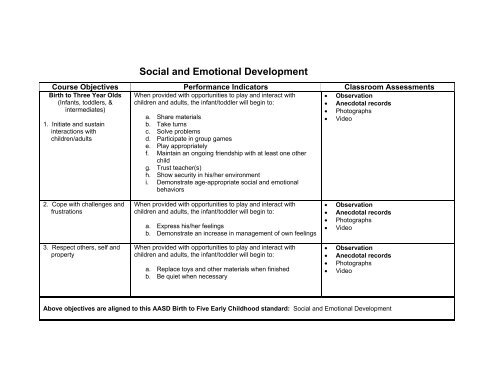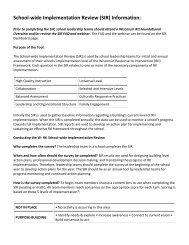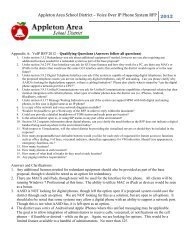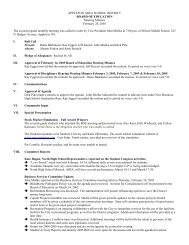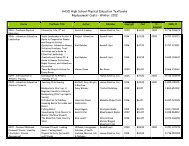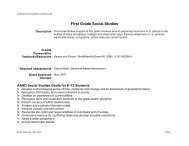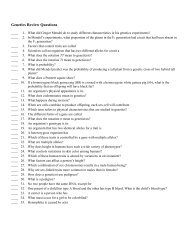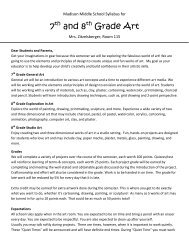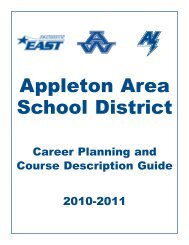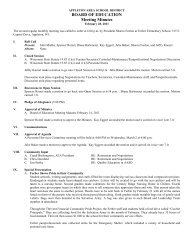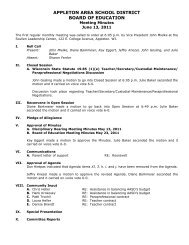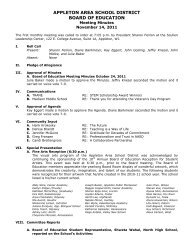Social and Emotional Development
Social and Emotional Development
Social and Emotional Development
You also want an ePaper? Increase the reach of your titles
YUMPU automatically turns print PDFs into web optimized ePapers that Google loves.
<strong>Social</strong> <strong>and</strong> <strong>Emotional</strong> <strong>Development</strong>Course Objectives Performance Indicators Classroom AssessmentsBirth to Three Year Olds(Infants, toddlers, &intermediates)When provided with opportunities to play <strong>and</strong> interact withchildren <strong>and</strong> adults, the infant/toddler will begin to:1. Initiate <strong>and</strong> sustaininteractions withchildren/adultsa. Share materialsb. Take turnsc. Solve problemsd. Participate in group gamese. Play appropriatelyf. Maintain an ongoing friendship with at least one otherchildg. Trust teacher(s)h. Show security in his/her environmenti. Demonstrate age-appropriate social <strong>and</strong> emotionalbehaviors• Observation• Anecdotal records• Photographs• Video2. Cope with challenges <strong>and</strong>frustrations3. Respect others, self <strong>and</strong>propertyWhen provided with opportunities to play <strong>and</strong> interact withchildren <strong>and</strong> adults, the infant/toddler will begin to:a. Express his/her feelingsb. Demonstrate an increase in management of own feelingsWhen provided with opportunities to play <strong>and</strong> interact withchildren <strong>and</strong> adults, the infant/toddler will begin to:a. Replace toys <strong>and</strong> other materials when finishedb. Be quiet when necessary• Observation• Anecdotal records• Photographs• Video• Observation• Anecdotal records• Photographs• VideoAbove objectives are aligned to this AASD Birth to Five Early Childhood st<strong>and</strong>ard: <strong>Social</strong> <strong>and</strong> <strong>Emotional</strong> <strong>Development</strong>
<strong>Social</strong> <strong>and</strong> <strong>Emotional</strong> <strong>Development</strong>Course Objectives Performance Indicators Classroom Assessments4. Underst<strong>and</strong> <strong>and</strong> followroutine <strong>and</strong> expectationsWhen provided with opportunities to play <strong>and</strong> interact withchildren <strong>and</strong> adults, the infant/toddler will begin to:a. Sit for a story or group activitiesb. Listenc. Attend to information provided by speakerd. Follow routines with adult help• Observation• Anecdotal records• Photographs• Video5. Make <strong>and</strong> express choices When provided with opportunities to play <strong>and</strong> interact withchildren <strong>and</strong> adults, the infant/toddler will begin to:a. Plan what to do during playb. Express plan to an adultc. Tell an adult what was actually done during play• Observation• Anecdotal records• Video• Language samplingAbove objectives are aligned to this AASD Birth to Five Early Childhood st<strong>and</strong>ard: <strong>Social</strong> <strong>and</strong> <strong>Emotional</strong> <strong>Development</strong>
1. Initiate <strong>and</strong> sustaininteractions withchildren/adults<strong>Social</strong> <strong>and</strong> <strong>Emotional</strong> <strong>Development</strong>Course Objectives Performance Indicators Classroom AssessmentsThree to Five Year Olds When provided with opportunities to play <strong>and</strong> interact with children<strong>and</strong> adults, the young child will:a. Share materialsb. Take turnsc. Solve problemsd. Participate in group gamese. Play cooperativelyf. Maintain an ongoing friendship with at least one other child• Observation• Anecdotal records• Photographs• Video2. Cope with challenges <strong>and</strong>frustrations3. Respect others, self, <strong>and</strong>propertyWhen provided with opportunities to play <strong>and</strong> interact with children<strong>and</strong> adults, the young child will:a. Express <strong>and</strong> underst<strong>and</strong> feelings of self <strong>and</strong> othersappropriatelyb. Demonstrate an increase in management of own feelingsWhen provided with opportunities to play <strong>and</strong> interact with children<strong>and</strong> adults, the young child will:a. Replace toys <strong>and</strong> other materials when finishedb. Speak with a quiet voicec. Recognize what another person might need or wantd. Wait for a turne. Be quiet when necessary• Observation• Anecdotal records• Photographs• Video• Observation• Anecdotal records• Photographs• VideoAbove objectives are aligned to this AASD Birth to Five Early Childhood st<strong>and</strong>ard: <strong>Social</strong> <strong>and</strong> <strong>Emotional</strong> <strong>Development</strong>
<strong>Social</strong> <strong>and</strong> <strong>Emotional</strong> <strong>Development</strong>Course Objectives Performance Indicators Classroom Assessments4. Underst<strong>and</strong> <strong>and</strong> follow When provided with opportunities to play <strong>and</strong> interact with childrenroutines <strong>and</strong> expectations <strong>and</strong> adults, the young child will:a. Sit for a story or group activitiesb. Listenc. Attend to information provided by a speakerd. Follow routines independently• Observation• Anecdotal records• Photographs• Video5. Make <strong>and</strong> express choices When provided with opportunities to play <strong>and</strong> interact with children<strong>and</strong> adults, the young child will:a. Plan what to do during playb. Express plan to an adultc. Tell an adult what was actually done during play• Observation• Anecdotal records• Photographs• VideoAbove objectives are aligned to this AASD Birth to Five Early Childhood st<strong>and</strong>ard: <strong>Social</strong> <strong>and</strong> <strong>Emotional</strong> <strong>Development</strong>


